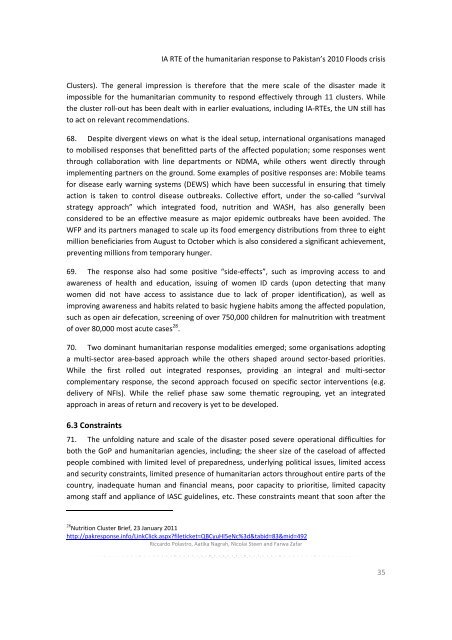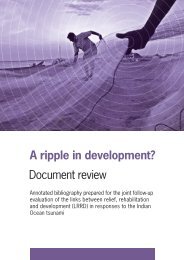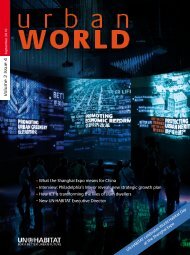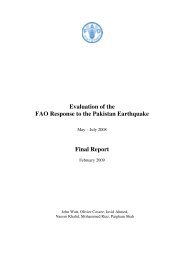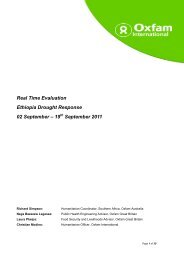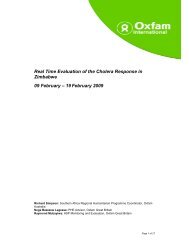Inter-Agency Real Time Evaluation of the Humanitarian ... - alnap
Inter-Agency Real Time Evaluation of the Humanitarian ... - alnap
Inter-Agency Real Time Evaluation of the Humanitarian ... - alnap
You also want an ePaper? Increase the reach of your titles
YUMPU automatically turns print PDFs into web optimized ePapers that Google loves.
IA RTE <strong>of</strong> <strong>the</strong> humanitarian response to Pakistan’s 2010 Floods crisis<br />
Clusters). The general impression is <strong>the</strong>refore that <strong>the</strong> mere scale <strong>of</strong> <strong>the</strong> disaster made it<br />
impossible for <strong>the</strong> humanitarian community to respond effectively through 11 clusters. While<br />
<strong>the</strong> cluster roll‐out has been dealt with in earlier evaluations, including IA‐RTEs, <strong>the</strong> UN still has<br />
to act on relevant recommendations.<br />
68. Despite divergent views on what is <strong>the</strong> ideal setup, international organisations managed<br />
to mobilised responses that benefitted parts <strong>of</strong> <strong>the</strong> affected population; some responses went<br />
through collaboration with line departments or NDMA, while o<strong>the</strong>rs went directly through<br />
implementing partners on <strong>the</strong> ground. Some examples <strong>of</strong> positive responses are: Mobile teams<br />
for disease early warning systems (DEWS) which have been successful in ensuring that timely<br />
action is taken to control disease outbreaks. Collective effort, under <strong>the</strong> so‐called “survival<br />
strategy approach” which integrated food, nutrition and WASH, has also generally been<br />
considered to be an effective measure as major epidemic outbreaks have been avoided. The<br />
WFP and its partners managed to scale up its food emergency distributions from three to eight<br />
million beneficiaries from August to October which is also considered a significant achievement,<br />
preventing millions from temporary hunger.<br />
69. The response also had some positive “side‐effects”, such as improving access to and<br />
awareness <strong>of</strong> health and education, issuing <strong>of</strong> women ID cards (upon detecting that many<br />
women did not have access to assistance due to lack <strong>of</strong> proper identification), as well as<br />
improving awareness and habits related to basic hygiene habits among <strong>the</strong> affected population,<br />
such as open air defecation, screening <strong>of</strong> over 750,000 children for malnutrition with treatment<br />
<strong>of</strong> over 80,000 most acute cases 28 .<br />
70. Two dominant humanitarian response modalities emerged; some organisations adopting<br />
a multi‐sector area‐based approach while <strong>the</strong> o<strong>the</strong>rs shaped around sector‐based priorities.<br />
While <strong>the</strong> first rolled out integrated responses, providing an integral and multi‐sector<br />
complementary response, <strong>the</strong> second approach focused on specific sector interventions (e.g.<br />
delivery <strong>of</strong> NFIs). While <strong>the</strong> relief phase saw some <strong>the</strong>matic regrouping, yet an integrated<br />
approach in areas <strong>of</strong> return and recovery is yet to be developed.<br />
6.3 Constraints<br />
71. The unfolding nature and scale <strong>of</strong> <strong>the</strong> disaster posed severe operational difficulties for<br />
both <strong>the</strong> GoP and humanitarian agencies, including; <strong>the</strong> sheer size <strong>of</strong> <strong>the</strong> caseload <strong>of</strong> affected<br />
people combined with limited level <strong>of</strong> preparedness, underlying political issues, limited access<br />
and security constraints, limited presence <strong>of</strong> humanitarian actors throughout entire parts <strong>of</strong> <strong>the</strong><br />
country, inadequate human and financial means, poor capacity to prioritise, limited capacity<br />
among staff and appliance <strong>of</strong> IASC guidelines, etc. These constraints meant that soon after <strong>the</strong><br />
28<br />
Nutrition Cluster Brief, 23 January 2011<br />
http://pakresponse.info/LinkClick.aspx?fileticket=QBCyuHI5eNc%3d&tabid=83&mid=492<br />
Riccardo Polastro, Aatika Nagrah, Nicolai Steen and Farwa Zafar<br />
35


